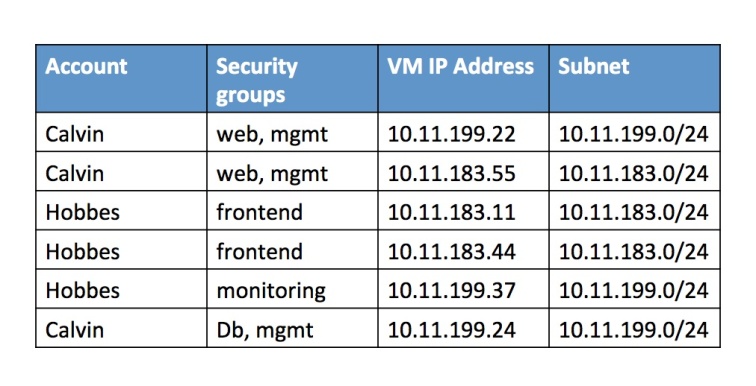In my last post I sang the praise of the simplicity of Basic Networking. There’s a few more details which even seasoned users of CloudStack may not be aware of:
- Security group rules are stateful. This means active connections enabled by the rules are tracked so that traffic can flow bidirectionally. Although UDP and ICMP are connectionless protocols, their “connection” is defined by the tuple. Stateful connection also has the somewhat surprising property that if you remove a rule, the existing connections enabled by rule continue to exist, until closed by either end of the connection. This is identical to AWS security groups behavior.
- Security group rules can allow access to VMs from other accounts: Suppose you have a shared monitoring service across accounts. The VMs in the monitoring service can belong to the cloud operator. Other tenants can allow access to them:
-
> authorize securitygroupingress securitygroupname=web account=operator usersecuritygrouplist=nagios,cacti protocol=tcp startport=12489 ...
-
- There is always a default security group: Just like EC2-classic, if you don’t place a VM in a security group, it gets placed in the default security group. Each account has its own default security group.
- Security group rules work between availability zones: Security groups in an account are common across a region (multiple availability zones). Therefore, if the availability zones are routable (without NAT) to each other then the security groups work just as well between zones. This is similar to AWS EC2-classic security groups.
- Subnets are shared between accounts / VMs in a security group may not share a subnet. Although tenants cannot create or choose subnets in Basic networking, their VMs are placed in subnets (“Pods”) predefined by the cloud operator. The table below shows a sample of VMs belonging to two accounts spread between two subnets.
- BUM traffic is silently dropped. Broadcast and multicast traffic is dropped at the VM egress to avoid attacks on other tenants in the same subnet. VMs cannot spoof their mac address either: unicast traffic with the wrong source mac is dropped as well.
- Anti-spoofing protection. VMs cannot spoof their mac address. VMs cannot send ARP responses for IP addresses they do not own. VMs cannot spoof DHCP server responses either. ARP is allowed only when the source MAC matches the VM’s assigned MAC. DHCP and DNS queries to the pod-local DHCP server are always allowed. If you run Wireshark/tcpdump within the VM you cannot see your neighbors traffic even though your NIC is set to promiscuous mode.
- Multiple IP addresses per VM: Once the VM is started you can request an additional IP for the VM (use the addIptoNic API).
- Live migration of the VM works as expected: When the operator migrates a VM, the security group rules move with the VM. Existing connections may get dropped during the migration.
- High Availability: As with any CloudStack installation, High Availability (aka Fast Restart) works as expected. When the VM moves to a different host, the rules move along with the VM.
- Effortless scaling: The largest CloudStack clouds (tens of thousands of nodes) use Basic networking. Just add more management servers.
- Available LBaaS: You can use a Citrix Netscaler to provide load balancing as well as Global Server Load Balancing (GSLB)
- Available Static NAT: You can use a Citrix Netscaler to provide Static NAT from a “public” IP to the VM IP.
There are limitations however when you use Basic Zone:
- Security groups function is only available on Citrix XenServer and KVM
- You can’t mix Advanced Networks and Basic Networks in the same availability zone, unlike AWS EC2
- You can’t add/remove security groups to a VM after it has been created. This is the same as EC2-classic
- No VPN functions are available.
The best way to deploy your Basic Zone is to engineer your physical network according to the same principles as web-scale operators. Read on…

One thought on “CloudStack Basic Networking : deeper dive”